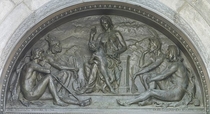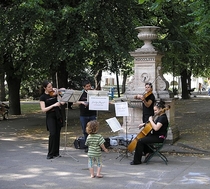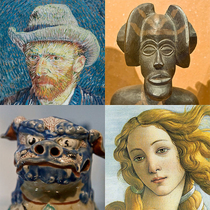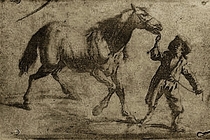
History
History (from Greek ἱστορία, historia, meaning 'inquiry; knowledge acquired by investigation') is the study of the past. Events occurring before the invention of writing systems are considered prehistory. "History" is an umbrella term that relates to past events as well as the memory, discovery, collection, organization, presentation, and interpretation of information about these events. Scholars who focus on history are called historians. The historian's role is to place the past in context, using sources from moments and events, and filling in the gaps to the best of their ability. Written documents are not the only sources historians use to develop their understanding of the past. They also use material objects, oral accounts, ecological markers, art, and artifacts as historical sources. History also includes the academic discipline which uses narrative to describe, examine, question, and analyze a sequence of past events, investigate the patterns of cause and effect that are related to them. Historians seek to understand and represent the past through narratives. They often debate which narrative best explains an event, as well as the significance of different causes and effects. Historians also debate the nature of history and its usefulness by discussing the study of the discipline as an end in itself and as a way of providing "perspective" on the problems of the present. Stories common to a particular culture, but not supported by external sources (such as the tales surrounding King Arthur), are usually classified as cultural heritage or legends. History differs from myth in that it is supported by evidence. However, ancient influences have helped spawn variant interpretations of the nature of history which have evolved over the centuries and continue to change today. The modern study of history is wide-ranging, and includes the study of specific regions and the study of certain topical or thematic elements of historical investigation. History is often taught as part of primary and secondary education, and the academic study of history is a major discipline in university studies. Herodotus, a 5th-century BC Greek historian is often considered (within the Western tradition) to be the "father of history," or, by some, the "father of lies." Along with his contemporary Thucydides, he helped form the foundations for the modern study of human history. Their works continue to be read today, and the gap between the culture-focused Herodotus and the military-focused Thucydides remains a point of contention or approach in modern historical writing. In East Asia, a state chronicle, the Spring and Autumn Annals, was known to be compiled from as early as 722 BC although only 2nd-century BC texts have survived.
See all
0
0
Travel
Travel is the movement of people between distant geographical locations. Travel can be done by foot, bicycle, automobile, train, boat, bus, airplane, ship or other means, with or without luggage, and can be one way or round trip. Travel can also include relatively short stays between successive movements, as in the case of tourism.
See all
0
0

Jewish holidays
Jewish holidays, also known as Jewish festivals or Yamim Tovim (ימים טובים, or singular יום טוב in transliterated Hebrew []), are holidays observed in Judaism and by Jews throughout the Hebrew calendar. They include religious, cultural and national elements, derived from three sources: biblical mitzvot ("commandments"); rabbinic mandates; Jewish history and the history of the State of Israel. Jewish holidays occur on the same dates every year in the Hebrew calendar, but the dates vary in the Gregorian. This is because the Hebrew calendar is a lunisolar calendar (based on the cycles of both the sun and moon), whereas the Gregorian is a solar calendar.
See all
0
0

Tradition
A tradition is a belief or behavior (folk custom) passed down within a group or society with symbolic meaning or special significance with origins in the past. A component of folklore, common examples include holidays or impractical but socially meaningful clothes (like lawyers' wigs or military officers' spurs), but the idea has also been applied to social norms such as greetings. Traditions can persist and evolve for thousands of years—the word tradition itself derives from the Latin tradere literally meaning to transmit, to hand over, to give for safekeeping. While it is commonly assumed that traditions have ancient history, many traditions have been invented on purpose, whether that be political or cultural, over short periods of time. Various academic disciplines also use the word in a variety of ways. The phrase "according to tradition", or "by tradition", usually means that whatever information follows is known only by oral tradition, but is not supported (and perhaps may be refuted) by physical documentation, by a physical artifact, or other quality evidence. Tradition is used to indicate the quality of a piece of information being discussed. For example, "According to tradition, Homer was born on Chios, but many other locales have historically claimed him as theirs." This tradition may never be proven or disproven. In another example, "King Arthur, by tradition a true British king, has inspired many well loved stories." Whether they are documented fact or not does not decrease their value as cultural history and literature. Traditions are a subject of study in several academic fields, especially in social sciences such as folklore studies, anthropology, archaeology, and biology. The concept of tradition, as the notion of holding on to a previous time, is also found in political and philosophical discourse. For example, it is the basis of the political concept of traditionalism, and also strands of many world religions including traditional Catholicism. In artistic contexts, tradition is used to decide the correct display of an art form. For example, in the performance of traditional genres (such as traditional dance), adherence to guidelines dictating how an art form should be composed are given greater importance than the performer's own preferences. A number of factors can exacerbate the loss of tradition, including industrialization, globalization, and the assimilation or marginalization of specific cultural groups. In response to this, tradition-preservation attempts have now been started in many countries around the world, focusing on aspects such as traditional languages. Tradition is usually contrasted with the goal of modernity and should be differentiated from customs, conventions, laws, norms, routines, rules and similar concepts.
See all
1
0

Wine
Wine is an alcoholic drink typically made from fermented grapes. Yeast consumes the sugar in the grapes and converts it to ethanol, carbon dioxide, and heat. Different varieties of grapes and strains of yeasts produce different styles of wine. These variations result from the complex interactions between the biochemical development of the grape, the reactions involved in fermentation, the grape's growing environment (terroir), and the production process. Many countries enact legal appellations intended to define styles and qualities of wine. These typically restrict the geographical origin and permitted varieties of grapes, as well as other aspects of wine production. Wines not made from grapes involve fermentation of additional crops including, rice wine and other fruit wines such as plum, cherry, pomegranate, currant and elderberry. Wine has been produced for thousands of years. The earliest evidence of wine is from Georgia (6000 BC), and Sicily (4000 BC). New World wine has some connection to alcoholic beverages made by the indigenous peoples of the Americas, but is mainly connected to later Viking area of Vinland and Spanish traditions in New Spain. Later, as Old World wine further developed viticulture techniques, Europe would encompass three of the largest wine-producing regions. Today, the five countries with the largest wine-producing regions are in Italy, Spain, France, the United States, and China. Wine has long played an important role in religion. Red wine was associated with blood by the ancient Egyptians and was used by both the Greek cult of Dionysus and the Romans in their Bacchanalia; Judaism also incorporates it in the Kiddush and Christianity in the Eucharist. Egyptian, Greek, Roman, and Israeli wine cultures are still connected to these ancient roots. Similarly the largest wine regions in Italy, Spain, and France, have heritages in connection to sacramental wine, likewise, viticulture traditions in the Southwestern United States started within New Spain as Catholic friars and monks first produced wines in New Mexico and California.
See all
0
0

Food
Food is any substance consumed to provide nutritional support for an organism. Food is usually of plant or animal origin, and contains essential nutrients, such as carbohydrates, fats, proteins, vitamins, or minerals. The substance is ingested by an organism and assimilated by the organism's cells to provide energy, maintain life, or stimulate growth. Historically, humans secured food through two methods: hunting and gathering and agriculture, which gave modern humans a mainly omnivorous diet. Worldwide, humanity has created numerous cuisines and culinary arts, including a wide array of ingredients, herbs, spices, techniques, and dishes. Today, the majority of the food energy required by the ever-increasing population of the world is supplied by the food industry. Food safety and food security are monitored by agencies like the International Association for Food Protection, World Resources Institute, World Food Programme, Food and Agriculture Organization, and International Food Information Council. They address issues such as sustainability, biological diversity, climate change, nutritional economics, population growth, water supply, and access to food. The right to food is a human right derived from the International Covenant on Economic, Social and Cultural Rights (ICESCR), recognizing the "right to an adequate standard of living, including adequate food", as well as the "fundamental right to be free from hunger".
See all
0
0

Dog
The dog (Canis familiaris when considered a distinct species or Canis lupus familiaris when considered a subspecies of the wolf) The dog and the extant gray wolf are sister taxa Dogs vary widely in shape, size and colors. They perform many roles for humans, such as hunting, herding, pulling loads, protection, assisting police and military, companionship and, more recently, aiding disabled people and therapeutic roles. This influence on human society has given them the sobriquet of "man's best friend".
See all
0
0

Orchestra
An orchestra is a large instrumental ensemble typical of classical music, which combines instruments from different families, including bowed string instruments such as the violin, viola, cello, and double bass, brass instruments such as the horn, trumpet, trombone and tuba, woodwinds such as the flute, oboe, clarinet and bassoon, and percussion instruments such as the timpani, bass drum, triangle, snare drum, cymbals, and mallet percussion instruments each grouped in sections. Other instruments such as the piano and celesta may sometimes appear in a fifth keyboard section or may stand alone, as may the concert harp and, for performances of some modern compositions, electronic instruments. A full-size Western orchestra may sometimes be called a ' or philharmonic orchestra (phil-, Greek for "loving" + "harmonic"). The actual number of musicians employed in a given performance may vary from seventy to over one hundred musicians, depending on the work being played and the size of the venue. A ' (sometimes concert orchestra'') is a smaller-sized ensemble of about fifty musicians or fewer. Orchestras that specialize in the Baroque music of, for example, Johann Sebastian Bach and George Frideric Handel, or Classical repertoire, such as that of Haydn and Mozart, tend to be smaller than orchestras performing a Romantic music repertoire, such as the symphonies of Johannes Brahms. The typical orchestra grew in size throughout the 18th and 19th centuries, reaching a peak with the large orchestras (of as many as 120 players) called for in the works of Richard Wagner, and later, Gustav Mahler. Orchestras are usually led by a conductor who directs the performance with movements of the hands and arms, often made easier for the musicians to see by use of a conductor's baton. The conductor unifies the orchestra, sets the tempo and shapes the sound of the ensemble. The conductor also prepares the orchestra by leading rehearsals before the public concert, in which the conductor provides instructions to the musicians on their interpretation of the music being performed. The leader of the first violin section, commonly called the concertmaster, also plays an important role in leading the musicians. In the Baroque music era (1600–1750), orchestras were often led by the concertmaster or by a chord-playing musician performing the basso continuo parts on a harpsichord or pipe organ, a tradition that some 20th-century and 21st-century early music ensembles continue. Orchestras play a wide range of repertoire, including symphonies, opera and ballet overtures, concertos for solo instruments, and as pit ensembles for operas, ballets, and some types of musical theatre (e.g., Gilbert and Sullivan operettas). Amateur orchestras include those made up of students from an elementary school or a high school, youth orchestras, and community orchestras; the latter two typically being made up of amateur musicians from a particular city or region. The term orchestra derives from the Greek ὀρχήστρα (orchestra), the name for the area in front of a stage in ancient Greek theatre reserved for the Greek chorus.
See all
0
0

Classical music
Classical music is art music produced or rooted in the traditions of Western culture, including both liturgical (religious) and secular music. While a more precise term is also used to refer to the period from 1750 to 1820 (the Classical period), this article is about the broad span of time from before the 6th century AD to the present day, which includes the Classical period and various other periods. The central norms of this tradition became codified between 1550 and 1900, which is known as the common-practice period.
See all
0
0

Art
Art is a diverse range of human activities in creating visual, auditory or performing artifacts (artworks), expressing the author's imaginative, conceptual ideas, or technical skill, intended to be appreciated for their beauty or emotional power. Other activities related to the production of works of art include the criticism of art, the study of the history of art, and the aesthetic dissemination of art. The three classical branches of art are painting, sculpture and architecture. Music, theatre, film, dance, and other performing arts, as well as literature and other media such as interactive media, are included in a broader definition of the arts. Until the 17th century, art referred to any skill or mastery and was not differentiated from crafts or sciences. In modern usage after the 17th century, where aesthetic considerations are paramount, the fine arts are separated and distinguished from acquired skills in general, such as the decorative or applied arts. Though the definition of what constitutes art is disputed and has changed over time, general descriptions mention an idea of imaginative or technical skill stemming from human agency and creation. The nature of art and related concepts, such as creativity and interpretation, are explored in a branch of philosophy known as aesthetics.
See all
1
0

Photography
Photography is the art, application and practice of creating durable images by recording light or other electromagnetic radiation, either electronically by means of an image sensor, or chemically by means of a light-sensitive material such as photographic film. It is employed in many fields of science, manufacturing (e.g., photolithography), and business, as well as its more direct uses for art, film and video production, recreational purposes, hobby, and mass communication. Typically, a lens is used to focus the light reflected or emitted from objects into a real image on the light-sensitive surface inside a camera during a timed exposure. With an electronic image sensor, this produces an electrical charge at each pixel, which is electronically processed and stored in a digital image file for subsequent display or processing. The result with photographic emulsion is an invisible latent image, which is later chemically "developed" into a visible image, either negative or positive depending on the purpose of the photographic material and the method of processing. A negative image on film is traditionally used to photographically create a positive image on a paper base, known as a print, either by using an enlarger or by contact printing.
See all
0
0

Photograph
A photograph (also known as a photo) is an image created by light falling on a photosensitive surface, usually photographic film or an electronic image sensor, such as a CCD or a CMOS chip. Most photographs are created using a camera, which uses a lens to focus the scene's visible wavelengths of light into a reproduction of what the human eye would see. The process and practice of creating such images is called photography.
See all
0
0

Argentine tango
Argentine tango is a musical genre and accompanying social dance originating at the end of the 19th century in the suburbs of Buenos Aires and Montevideo. It typically has a or rhythmic time signature, and two or three parts repeating in patterns such as ABAB or ABCAC. Its lyrics are marked by nostalgia, sadness, and laments for lost love. The typical orchestra has several melodic instruments and is given a distinctive air by the small button accordion called the bandoneon. It has continued to grow in popularity and spread internationally, adding modern elements without replacing the older ones. Among its leading figures are the singer and songwriter Carlos Gardel and composers/performers Francisco Canaro, Juan D'Arienzo, Carlos Di Sarli, Osvaldo Pugliese, and Ástor Piazzolla.
See all
0
0








Comments